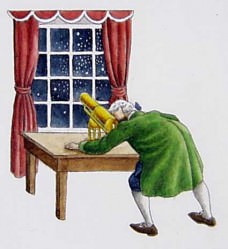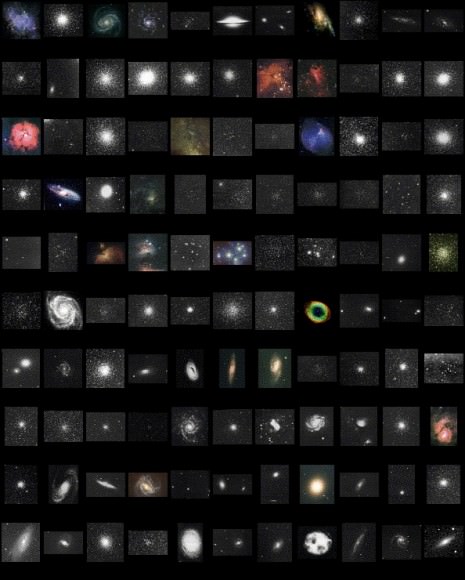Charles Messier was born on June 26, 1730 in Lorraine, France. In 1744 at age fourteen, he saw the “Great Comet” appear in the skies above Lorraine and four years later in 1748, witnessed an annular solar eclipse. Perhaps it was these inspiring events that led Charles to a lifelong love of astronomy. In 1751, his excellence in handwriting brought him a job as assistant to Navy Astronomer, Joseph Delisle at the Paris Observatory. It was there that Messier learned to keep accurate records of astronomical observations and the first known entry made by Messier was the transit of Mercury across the Sun in 1753.
At the time, discovering a comet made an astronomer not only noteworthy in the eyes of their peers, but quite famous as well. In 1757 the big search was on for the Comet Halley – predicted to return during that year. While Charles wasn’t the first to locate it, he quickly came to realize during his “sweeps” that there were many objects which could be mistaken as cometary – yet remained in fixed positions. Thus began the Messier Catalog, and its first entry in 1758 was M1, the “Crab Nebula”. While Messier was compiling his catalog of non-cometary objects, he also discovered a genuine comet in 1763 and two more in 1764.
 Charles’ catalog was published in several editions as it was amended and the first 45 entries was printed in 1771. In its classic form, it contained 103 entries. In later years, after careful study of his notes, Dr. Helen Sawyer Hogg and Dr. Owen Gingerich would suggest that another four to six objects should be added to bring the total to 110 – the Messier Catalog we know today. Not all of the objects were his original discovery – a fact which he made clear in his notes – and it is rather ironic that what Messier thought of to be “nuisance nebula” that might confuse the comet hunter would later become his major claim to fame. With his small telescopes aimed towards the night sky, he would give future generations of astronomers one of the finest sets of targets for mid-northern latitudes to enjoy.
Charles’ catalog was published in several editions as it was amended and the first 45 entries was printed in 1771. In its classic form, it contained 103 entries. In later years, after careful study of his notes, Dr. Helen Sawyer Hogg and Dr. Owen Gingerich would suggest that another four to six objects should be added to bring the total to 110 – the Messier Catalog we know today. Not all of the objects were his original discovery – a fact which he made clear in his notes – and it is rather ironic that what Messier thought of to be “nuisance nebula” that might confuse the comet hunter would later become his major claim to fame. With his small telescopes aimed towards the night sky, he would give future generations of astronomers one of the finest sets of targets for mid-northern latitudes to enjoy.
It isn’t long before the novice astronomer becomes aware of the “Messier List” – and rightly so. This wonderful collection of deep sky gems are easily accessible to a small telescope and most can even be perceived in binoculars. A large majority of the objects can be conquered easily with modest instruments under less than perfect sky conditions, a few can be seen with the unaided eye and some are quite challenging. As a whole, they make for great nights of study, piquing both interest and intellect, as well as observing skills. They range from vague misty patches to grand swaths of stellar landscape!
 The Messier Objects (as presented here), contain proper sky coordinates for setting circles or entry into GoTo systems. You’ll also find included a rough map of location, descriptions, scientific information and history. Do not be disappointed if your observations don’t match the grand photos that accompany each article. It is unfortunate that photography can’t always depict what can be seen at the eyepiece, but do rejoice that you are catching a smudge that’s such a huge distance away! Do not give up if you don’t find a particular object easily… Conquering the Messier list takes time and patience. There are also many fine organizations that offer awards for observing the Messier List and instructions for participation can be easily found on the web. Most of all? Enjoy your observations!
The Messier Objects (as presented here), contain proper sky coordinates for setting circles or entry into GoTo systems. You’ll also find included a rough map of location, descriptions, scientific information and history. Do not be disappointed if your observations don’t match the grand photos that accompany each article. It is unfortunate that photography can’t always depict what can be seen at the eyepiece, but do rejoice that you are catching a smudge that’s such a huge distance away! Do not give up if you don’t find a particular object easily… Conquering the Messier list takes time and patience. There are also many fine organizations that offer awards for observing the Messier List and instructions for participation can be easily found on the web. Most of all? Enjoy your observations!
Charles Messier (archival image), Messier Objects Poster courtesy of SEDS.


